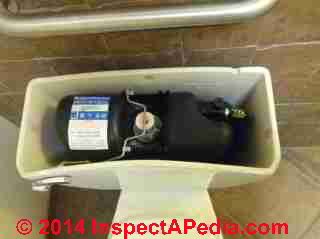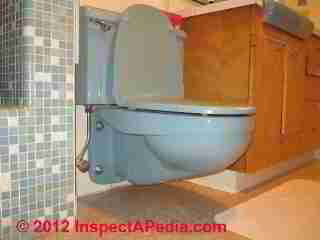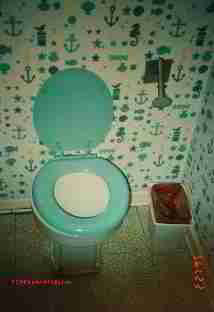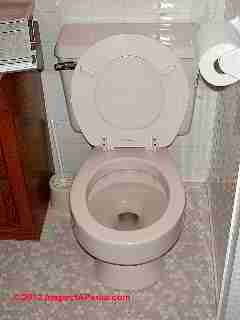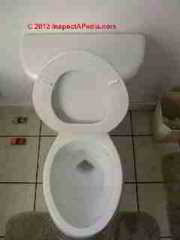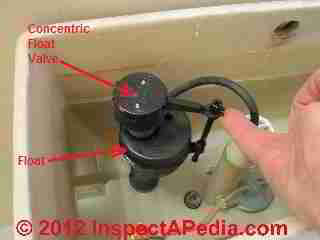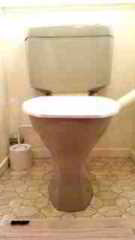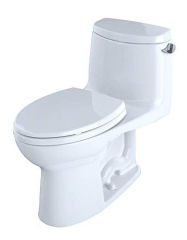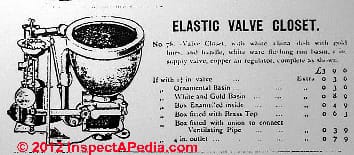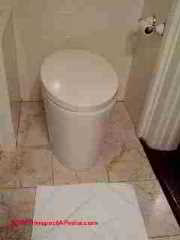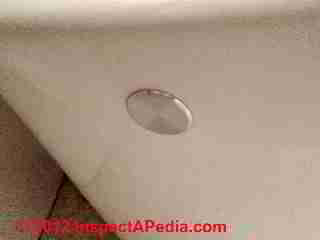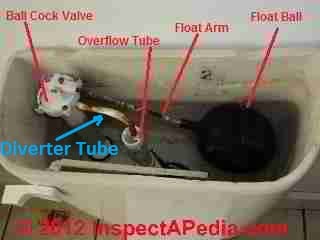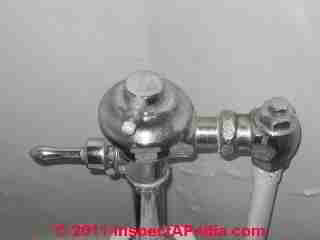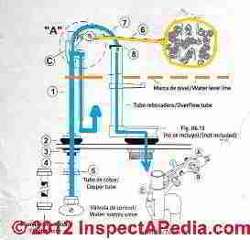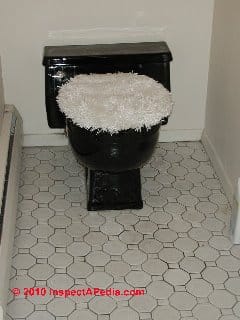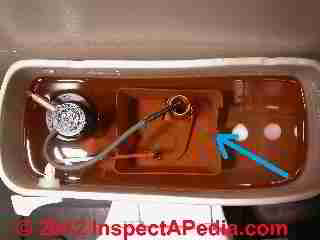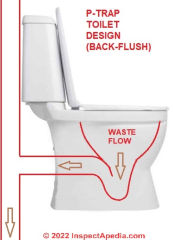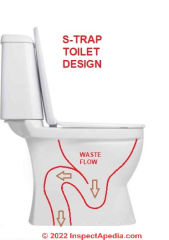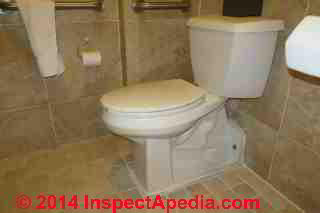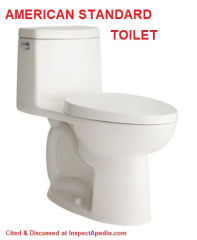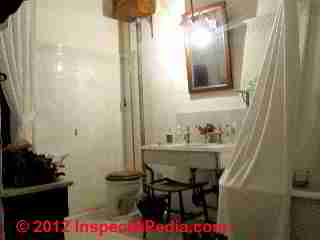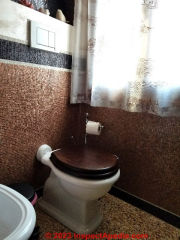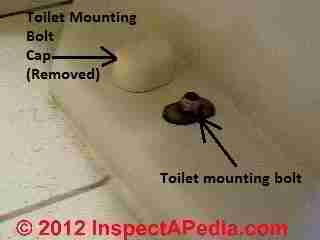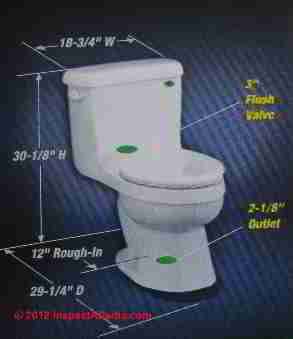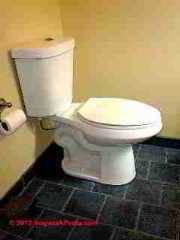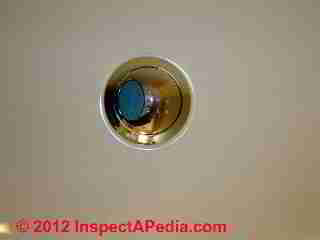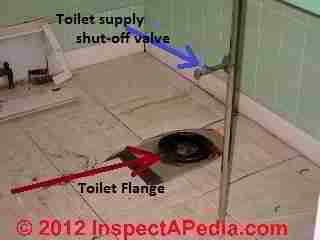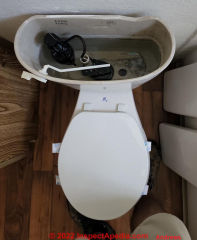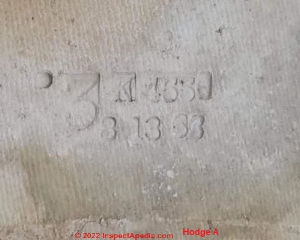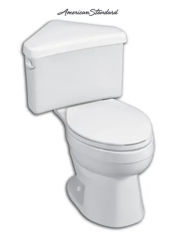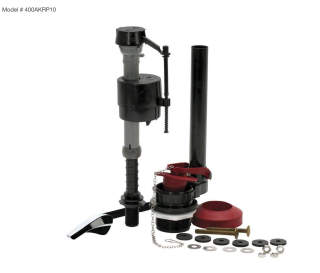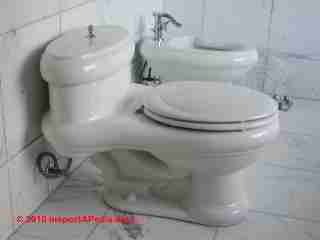 Toilet Encyclopedia
Toilet Encyclopedia
Toilet types, sources, repairs
- POST a QUESTION or COMMENT about the history, models, & types of toilets & toilet flushing or operating mechanisms
Guide to types & designs of toilets:
Illustrated List of All Types of Toilets, How to Identify Toilet Parts, How each type of toilet works.
We include a complete list of every type of toilet with links to more in-depth descriptions of each of these.
This article series describes the different types and models of toilets: historical or old toilet types, wooden high wall-tank toilets, conventional reservoir tank toilets, low-flush toilets, water saving toilets, back-flush toilets, up-flush toilets, and even chemical toilets.
Here we explain how to diagnose and repair problems with toilets, leaks, flushes, odors, noises, running and wasted water.
InspectAPedia tolerates no conflicts of interest. We have no relationship with advertisers, products, or services discussed at this website.
Types of Toilets & Toilet Controls & Parts for Water Closets, Elastic Valve Closets
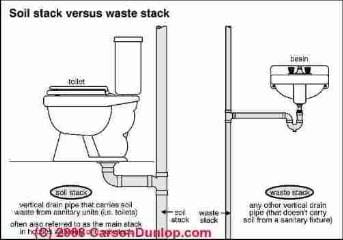
All modern toilets receive human waste, urine, feces, and are intended to dispose of that matter in a sanitary fashion.
By the late 1800's the development of the modern flush-toilet, replacing chamber pots and outhouses, toilets have relied on a dose of water to flush waste out of the toilet bowl into sewage piping or into a private septic system for wastewater treatment and disposal.
Take a look at the simple connection between a typical reservoir-tank toilet and the soil stack (waste piping) in the Carson Dunlop Associates sketch (left). This illustrates how most toilets are connected to a building drain.
Back flush and up-flush toilets use a higher in-wall connection and are also explained in the article below along with squat toilets. This article also includes a dictionary of toilet parts and features.
This article describes all types of toilets: tank-reservoir flush toilets & tank reservoir top flush controls. Low profile or small tank toilets. Low water consumption toilets - gallons per flush numbers .
Back flush / rear flush toilets, reservoir tank & tankless designs. Electric toilets & pressure assisted-flush toilets. Flushometer toilets & urinals. Basement & other up-flush toilets & basement toilets using a sewage ejector pump.
Photos & descriptions of sizes, shapes, features of historic & modern toilets including the Japanese bidet toilet. Toilet Brands List, Manufacturers, Contact Information for all Toilet Brands
[Click to enlarge any image]
Toilet Terminology, Definitions, Parts, & How Flush Toilets Work - what each part does
This is an alphabetical list of definitions of toilet parts & terms, these terms & key parts of toilets - we include links or references for more detail for most of these terms or toilet types or features.
Air & Water Powered Flush Toilets (Pressure Assist): the Sloan Flushmate
Details for power assist or power flush toilets like Sloan's Flushmate are found
at LOW WATER USAGE / POWER FLUSH TOILETS.
Power flush toilet model shown in our photo below: Sloan Flushmate® Model M-101526-F3 using a 1.6 gpf or 6LPF toilet flush volume. Other Flushmate® toilet models (Flushmate IV) use less than 1 gallon per flush.
The FLUSHMATE® system traps air and as it fills with water, it uses the water supply line pressure to compress the trapped air inside.
The compressed air is what forces the water into the bowl, so instead of the “pulling” or siphon action of a gravity unit, the pressure-assist unit “pushes” waste out.
This vigorous flushing action cleans the bowl better than gravity units. - quoted from www.flushmate.com, retrieved 2/2/2014
At FLUSHMATE TOILETS we discuss power-assisted flush toilets that also conserve water.
Also see water conserving or water saving toilets that use different flush volumes for urine than for solid waste, now discussed at
TOP FLUSH TOILETS and at
DUAL FLUSH TOILETS.
Back-flush & Rear Flush Toilets
A back-flush toilet is designed to flush horizontally out of the lower back of the bowl into a waste pipe that is mounted in the wall behind the unit. In comparison, a standard bottom-flush toilet is connected to a waste pipe in the floor below the unit.
A traditional back-flush toilet is designed to work by gravity alone. Also see Up-Flush toilets, Rear-flush toilets, Toilets using a Sewage Ejector Pump, and Electric or pump operated toilets in these definitions.
Our guide to back-flush toilets got promoted to its own web page now found
at BACK FLUSH & WALL MOUNT TOILETS .
Ball cock valve = Toilet Fill Valve
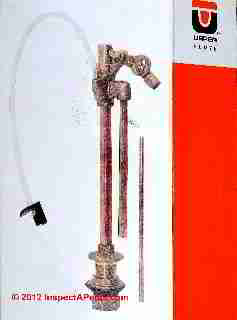 The toilet fill valve admits water into the toilet reservoir tank or cistern to refill the cistern following a toilet flush. Most fill valve designs also send some water through the overflow tube and into the toilet bowl during cistern re-fill.
The toilet fill valve admits water into the toilet reservoir tank or cistern to refill the cistern following a toilet flush. Most fill valve designs also send some water through the overflow tube and into the toilet bowl during cistern re-fill.
Two common fill valve designs in current use are the ball-cock toilet fill valve and the concentric float toilet fill valve. Both of those designs are illustrated above. Synonyms for toilet fill valves include: ball cock valve, concentric float valve, toilet water supply valve, toilet tank fill valve.
The toilet ball cock fill valve shown in our photo of a traditional side-float brass ball cock valve by Urrer, and in our sketch at below left left, the ball cock valve is the control that refills the toilet tank after a flush. the rod that carries the float, the float itself and other toilet parts are not shown in this illustration.
Toilet ball cock fill valve control designs include older tank-bottom sill-cock valves and modern anti-siphon valves (shown at left).
The diverter tube is clipped to the top of the toilet cistern tank overflow tube to deliver some water to the toilet bowl during tank refill.
The blue arrow indicates where the ball cock valve sends water into the toilet tank or cistern.
The float arm connector receives the float arm that carries the float ball assembly.
Ball cock valve adjustment: Most ball cock toilet fill valves have two screw or thumbscrew adjustments. One adjusts the angle of the float arm by moving the float arm connector position. The second adjusts the valve shut-off or closure point.
Set both of these so that the water level in the toilet cistern or tank is at the "fill line" marked on the cistern body.
A modern anti-siphon sanitary ball cock valve places the water admitting assembly at the top of the valve while older units were "upside down", placing the admitting valve at the bottom of the toilet tank.
A bottom-admitting ball-cock or other toilet fill valve is considered unsanitary by modern plumbing codes because in the event that the building loses water pressure, potentially unsanitary water can flow backwards from the toilet reservoir tank into the building water supply piping.
Details are at TOILET FILL VALVE
Basement & Other Up-Flush Toilets for Toilets Located Below the Sewer Piping, No Toilet Tank
A variation on the flush valve toilet is the up-flush toilet used in bathrooms whose toilet was located below the building's sewer line exit to the sewer or septic system .
See details at BASEMENT & UP-FLUSH TOILETS & EJECTOR PUMPS
Bidet toilets & toilet seats
Moved to BIDETS
Bowl shapes of toilets
There are two basic toilet bowl profiles or shapes, round (which are not necessarily exactly round - illustrated at below left where a Church toilet seat is installed), and elongated or more of a flattened oval design (below right). Note that one of our readers used the term "water closet pan" to refer to the toilet bowl.
Watch out when buying a replacement toilet seat, to be sure you select the proper seat profile (round or elongated) to fit your toilet, or you'll be making an extra trip back to the store.
Concentric float toilet fill valves (photo at left) omit the rod, side-arm, and float ball. Instead a float rises on a vertical shaft that also supports the fill control valve.
In our photo my finger is pressing up on the lever that stops the flow of water into the toilet tank. You can see that an adjustable rod on the float (below the valve) will push up this stop lever on its own as the water level in the tank rises.
In some small-tank toilets we found that installing a concentric float toilet fill valve solved a problem of frequent jamming of the older side-float valve assembly whose float or rod would rub against the overflow tube or the toilet tank sides, jamming and giving recurrent "running toilet" problems.
Electric pump operated toilets make use of a pump to operate the toilet's flushing mechanism - that is, to clean the bowl.
Traditionally an electric pump toilet has no reservoir tank - the flush water is delivered to the unit with sufficient force and volume by the electric pump.
But some modern water saving toilets may employ an electric pump that adds water or air under pressure to improve the bowl cleaning action in the toilet while still using only a small volume of water.
Camping & Portable Toilets
CAMPING & EMERGENCY USE TOILETS - Camping toilets typically store wastewater in a reservoir for later dumping into an approved dumping station or septic system. Simple camping and emergency toilets typically use a plastic bag to contain solid waste for later pack-out and disposal.
Contemporary Toilet designs - photos, examples
This article topic has been moved
to CONTEMPORARY TOILET DESIGNS;
Contemporary Toilet Shapes, Sizes, Types, Designs - details
moved to CONTEMPORARY TOILET DESIGNS - TOILET SHAPES
Ceramic + Plastic Toilets & Low-Cost Toilets
In separate article now at LOW COST TOILETS we illustrate and explain the operation and connections for a 1981 McSkimming plastic toilet that remains perfectly functional in a home in Christchurch, New Zealand.
This toilet uses a ceramic bowl (the toilet lower portion or body) operated by a colour-matched cistern made of plastic.
Chemical Toilets
CHEMICAL TOILETS: use a chemically treated reservoir located directly below the toilet seat. The chemicals reduce odors and perform partial (incomplete) disinfection of the waste. While RV chemical toilets may store large quantities of wastewater, portable chemical toilets have limited storage capacity and must be emptied manually or pumped and periodically cleaned by a septic company.
Composting Toilets
A composting toilet is a self-contained unit (not connected to a septic or sewer system) which breaks-down and dehydrates human waste to a compost which can be added to soils.
See details at COMPOSTING TOILETS
Cyclone / Double-Cyclone Flush Toilets
Double cyclone flush toilets are a modern water-saving design using 1.28 gallons per flush.
The double cyclone toilet uses two nozzles to replace the standard holes around the rim of the toilet bowl in a design intended to clean the bowl successfully using less water.
Examples of double cyclone flush toilets include the Toto Ultramax II produced by Toto and shown above.
Toto describes the double-cyclone flush method:
The Double Cyclone flushing system by Toto first uses gravity to suck the water down from the toilet tank into two nozzles. From those nozzles, the water is then pushed into the bowl using centrifugal force so that it doesn’t go straight down but makes a 360° swirling motion. It’s a bit like a tornado cleaning your toilet bowl.
Don't confuse "Double Cyclone" flush toilets with Dual Flush toilets (listed below) are referred to in some product literature as "Tornado Flush™" toilets.
- TOTO UltraMax® II One-Piece Toilet, 1.28GPF MS604114CEF(R)(G) SPECIFICATIONS [PDF] Toto USA, Ph: (888) 295-8134 www.totousa.com
Disabled / Elderly-Use Toilets
DISABLED or ELDERLY-USE TOILETS discusses toilets for the elderly, disabled, sick, or injured
Dual Flush Toilets
See DUAL FLUSH TOILETS.
Early Flush Toilets: wall-mounted cisterns
Details are at ANTIQUE FLUSH TOILETS, excerpts from that article are just below:
Chamber pots (dating from Roman times and Garderobes (5th to 15th century toilets that simply dumped waste to the outdoors) and privies and outhouses, toilet designs that date to the 1500s or earlier are omitted from this review of modern toilets.
By the 1880's, in London Thomas Crapper & Co's sanitary specialties included the elastic valve water closet illustrated at left, and the toilet cistern "water waste preventer" siphon toilet flush assembly design illustrated in the article above.
See OUTHOUSES & LATRINES for examples of privies and outhouses, toilet designs that date to the 1500s or earlier
Electric Flush Toilets & Pressure Assisted-Flush Toilets
Our toilet photographs below illustrate a tankless, electric-flush toilet produced by Kohler. As you can see (below-left) the toilet may be a little unfamiliar to new visitors at the New Hampshire inn where this unit was installed.
Pressure-assisted flush toilets may use water pressure from the water mains to improve the flush cleansing of the bowl, or they may use a pump or an air bladder system that is in turn operated by water pressure.
By providing a more aggressive and higher velocity flush than a gravity flush toilet a pressure-assist system generally uses less water, ranging from 1.1 to 1.4 gallons.
Kohler Purist Hatbox Toilets
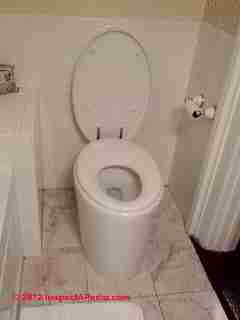
For a newcomer, flushing this Kohler hatbox toilet could be a bit of a mystery.
Searching for a flush lever or button finally leads to a round silver button located on the right side (if the user is seated) of the unit (photo, below).
Pushing the flush button on the older unit that we tested produced an aggressive and roaring "flush" along with a bit of pump noise.
Other literature describes these toilets as "quiet". Our photo at below left gives a clue about how this toilet was powered.
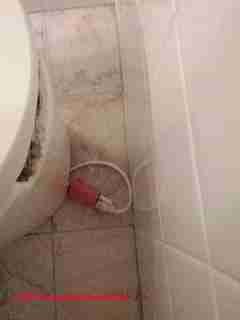
Newer versions of the electric flush toilet made by Kohler include a reservoir tank and an electric pump that moves water from the reservoir through the bowl and toilet trap.
This design offers a toilet that provides a low profile but nonetheless a very powerful flush in a compact design.
The Kohler hatbox toilet installation we examined had been in place for some time; this product is still available at a typical retail price of $2,725.
Emergency Use Toilets
and
See DISASTER ZONE TOILET GUIDE
Float Ball: Toilet Cistern / Tank Float Ball
The toilet tank float assembly activates the toilet fill valve as water level in the toilet tank or cistern drops during and at the end of a toilet flush.
Illustrated above at concentric float toilet fill valves, the float for that device is a cylinder that moves down or up on a vertical shaft as tank (cistern) water level in the cistern falls or rises, to open or close the fill valve itself.
A ball cock toilet fill valve is opened by movement of a float arm rod attached to a round float ball (illustrated at left) that drops as water level in the cistern falls during a flush, and the ball cock valve is closed as the float rises, lifting the rod to which it is attached as the water level in the toilet tank rises to the fill line.
In our photo (above left) a white plastic ball cock fill valve is shown in lieu of the older traditional brass and bronze ball cock valve illustrated earlier on this page.
Toilet Flush Valve or Flush Controls
The toilet flush valve sends water out of the toilet tank or cistern (conventional flush valves) or directly from the building water supply without a toilet tank or cistern (flushometer valves) into the toilet bowl below to flush waste into the building drain system.
The two most common toilet flush valves used on toilets that make use of a tank or cistern are the flapper type toilet flush valve (illustrated just below) and the tank ball type toilet flush valve (illustrated further below).
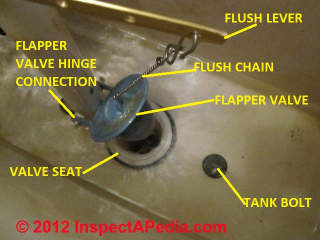
Flapper type toilet flush valve:
is a toilet flush valve that closes the opening at the bottom of the toilet tank using a semi-round flapper (usually rubber) rather than the rounded tank ball shown in the sketch.
Like the toilet tank ball type flush valve (illustrated in the sketch below), the flapper valve is pulled up to open the toilet reservoir tank drain opening to send flush water down into the toilet.
The shape and position of the flapper cause it to remain in the open position until the water level in the toilet tank drops to nearly empty, then the flapper "flaps" down over the drain opening to stop the toilet flush cycle and to permit the toilet fill cycle to begin anew.
Tank ball type flush valve:
the control that sends water from the toilet tank (or building water supply) into the toilet bowl to flush away waste. There are many models of flush valves, using varying designs.
A tank ball flush valve assembly is shown in the sketch at above left.
In a traditional side float flush valve assembly (sketch at left) the toilet is flushed by pressing on a handle outside the toilet tank that lifts a trip lever that pulls a chain or rod that lifts a tank ball or a tank flapper that otherwise seals the bottom of the toilet tank.
For modern toilets important are designs that conserve water either through the valve design itself (see Top Flush Control Toilets) or by means of a plastic "dam" around the valve assembly.
Flushometer Toilets & Urinals
Tankless flush-o-meter valve toilets, in widespread use in North America since the 1920's, and unlike tank reservoir toilets, do not include a reservoir tank of water.
The flushometer valve is particularly suitable to public restrooms since there is no delay between toilet uses waiting for a reservoir tank to refill. Typical flush volume is 1.6 gallons.
Details are at FLUSHOMETER TOILETS & URINALS
There we also discuss WATERLESS URINALS
Flushometer or flush-o-meter toilet valves & toilets: these tankless toilets are flushed using building water pressure and a vacuum-breaker valve control.
See FLUSHOMETER VALVES for TOILETS URINALS for details about these valves and how they are adjusted or repaired.
Also see Toilet Types, Flush Methods for a discussion of variations in toilet flush mechanisms & methods.
Gravity Flush Toilets
Gravity flush toilet:
(sketch above) the conventional and most common water-operated toilet world-wide is flushed by water that flows (from a reservoir tank) into the toilet bowl by gravity; the reservoir tank must be above and is typically attached to or part of the toilet assembly, though early flush toilets (illustrated below) placed the flush tank much higher on the wall in an effort to obtain a more cleansing flush for early bowl designs.
When the toilet is "flushed" using its handle, a flush control valve (see "tank ball in our sketch above) opens to send water from the reservoir into the toilet bowl to flush it clean.
At the end of the toilet flush, a ball cock valve or equivalent (#1 & assembly "C" in our sketch at above-left) refills the toilet tank from the building cold water supply (the fat blue arrow in our sketch).
Greywater Toilets (Graywater Toilets)
Use graywater to flush the toilet
See GREYWATER TOILETS & SEPTICS
Hatbox toilet: a tankless toilet design by Kohler that uses an electric pump to deliver flush water and adequate water velocity.
The hatbox toilet is illustrated
Incinerator Toilets - Waterless Toilets
Waterless toilets, other than composting toilets, are usually an incinerator model using gas or electricity to incinerate liquid and solid waste, leaving a very small volume of ash.
See details at INCINERATOR TOILET SYSTEMS
and at ALTERNATIVE & WATERLESS TOILETS
Low Profile or Small Tank Toilets - Poor Flush?
Our photo at above left of the black toilet shows a low-profile toilet design that has been popular in some communities since the 1970's.
Watch Out: we have found that some installations of low-profile toilets are also low-energy flushing fixtures that do not perform satisfactorily. If more than one flush is required to clean the toilet bowl, the system is wasting water.
- Check that the toilet tank is filling to the proper level (the water line marked in the tank interior).
- Check that the toilet drain line is not blocked.
- Check that the toilet drain line is properly vented.
- Or as our mom did in Boca Raton, replace the toilet if you cannot make it function properly.
For a low-profile toilet design that does not suffer from a weak flush,
See also LOW-HEIGHT TOILETS - lower seat heights or lower toilet rim heights
Low Water Consumption Toilets - Water Saving Toilets
Details are at
LOW WATER USAGE / POWER FLUSH TOILETS where we discuss toilet that use a reduced water quantity, and at
FLUSHMATE TOILETS we discuss power-assisted flush toilets that also conserve water. Excerpts are just below.
Also see water conserving or water saving toilets that use different flush volumes for urine than for solid waste, now discussed at
TOP FLUSH TOILETS and at
DUAL FLUSH TOILETS.
Water saving toilets use several strategies to reduce the volume of water used in flushing away waste: varying flush volume, pressure or power assisted flush using a small flush water volume, and reduced flush water volume using a reservoir barrier in th cistern or toilet tank.
At LOW WATER USAGE / POWER FLUSH TOILETS we give the various water volumes used by each toilet type and design.
Marine-Use Toilets
See details at MARINE TOILETS - toilets designed for use on boats, ships, similar vehicles
Outhouse Toilets & Latrines
See details at OUTHOUSES & LATRINES
Overflow tube, toilet: the overflow tube (item #8 in our sketch at left), is found on virtually all modern toilet flush control valve assemblies.
This tube prevents a malfunctioning toilet tank refill assembly from flooding the building. (Unfortunately if the toilet drain is clogged and the toilet overflows you'll have a different sort of flood
See TOILET OVERFLOW EMERGENCY.
During toilet tank re-fill, if the tank over-fills, the overflow tube (blue #7 in sketch at left) will excess water from the toilet reservoir tank down the overflow tube (#8) into the toilet bowl.
This is a critical function since otherwise if the toilet fill-valve malfunctions water entering the toilet tank will fill the tank to overflowing and leak into the building. But if your toilet is "running" the problem may be just that - the fill valve is sending water continuously into the tank where it enters the overflow tube.
Some toilet models use a separate cistern overflow drain that conducts water to a sewer line directly rather than routing it through the toilet bowl.
A second feature of most toilet fill valve assemblies and overflow tubes is that some water will be diverted from the fill valve into the overflow tube during the toilet tank fill-cycle - see the small curved blue tube marked #7 in our sketch above). This makes sure there is enough water in the toilet bowl before its next use.
Details are
Pressure-assist flush toilet
The pressure-assist flush toilet is flushed by water that is given a velocity boost by a pressure system using a pump,compressed, air, or other means. Typically pressure-assist toilet designs are found on water-saving low-flush-volume toilets.
See details about power-assisted flush or pressure-assist flush toilets
at LOW WATER USAGE / POWER FLUSH TOILETS.
Question: whooshing sound air boosted toilet flush sources
2016/09/10 Richard Baldwin said:
Hope you can help. Approximately eleven years ago we were remodeling two of our bathrooms. At the suggestion of the installer, we opted for type of apparatus in the tank I had never seen. There was no visible water in the tank, and instead, there was a rather large stainless steel tank which appeared to be a pressure tank.
When the toilet was flushed, there was a"wooshing" sound like air pressure. It was similar to the sound of toilets on cruise ships. It was very efficient and I would like to have one installed in our current home.
The installer is deceased and I cannot recall the type or brand. I do recall the cost was approximately one one hundred dollars more than a mid level conventional toilet. Can you help?
Reply:
Richard this sounds like a pressure-assisted flush toilet that uses a combination of building water pressure and an air charge to flush the toilet bowl while using less water than some other systems.
Searching InspectApedia for Power Assist or Pressure Assist Toilets finds the most detail about these
at LOW WATER USAGE / POWER FLUSH TOILETS.
There I use the "Air & Water Powered Flush Toilets (Pressure Assist): the Sloan Flushmate" as an example.
Pressure assist or "power assisted flush" toilets are also described
P-Trap or S-Trap Toilets: What's the Difference?
Below we illustrate the design difference between P-trap and S-trap toilets.
Both the P-trap and S-trap toilet designs ultimately connect to a building drain that should include a vertical vent stack as well - shown in our P-trap toilet illustration.
At least some experts asset that a toilet using a P-trap design does a better job of maintaining its water trap than an S-trap toilet.
On some but not all toilets, you can see the shape of the toilet's trap in the moulding of the ceramic toilet base. Above and below are examples of a P-trap shaped toilet design. The toilet above flushes down through a drain set into the floor.
The toilet below is a "back-flush" model that flushes out into a drain built into the wall. Back-flush toilets will provide a P-trap drain design.
Below is an American Standard toilet whose drain route might be described as an "S" trap but that rising drainage path before the drain angles down is intended to help preserve the water seal in the toilet bowl.
More about plumbing traps and their history is
RV Toilets
See details at RV TOILETS
Sewage Ejector Pumps
combine an in-floor reservoir to receive waste from toilets (and often gray water as well), and a sewage grinder pump to lift wastewater to a building drain line that is higher than the plumbing fixtures served by the pump.
Ejector pumps are often found in basement bathrooms in buildings whose sewer line exit above the height of the basement floor.
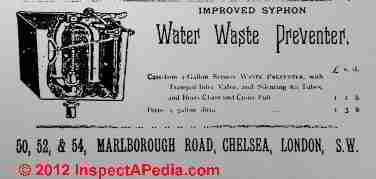 Siphon flush valve toilet:
Siphon flush valve toilet:
an alternative to the tank ball and flapper valve toilet flush mechanism used in the U.K. and in toilets in some other locales, toilet siphon flush valves are operated by a button that forces water up from the reservoir cistern (toilet tank) into the siphon that in turn sends water into the toilet bowl to complete the flush.
Siphon flush valve controls on toilets eliminate the problem of running toilets caused by leakage at the tank ball or flapper valve.
As you can see from our photo of an early toilet advertisement by Thomas Crapper & Cos. (from a wallpaper reproduction), the siphon flush valve is not a new idea, and has long been sold as a method of preventing water wastage and running toilets.
Toilet water storage tank (cistern) - wall-mount
The toilet water tank or "Cistern' is the water reservoir used to flush the toilet.
On antique flush toilets the cistern was mounted several feet above the toilet and secured to the building wall - illustrat5ed below, and discussed in detail
Toilet Water Storage Tank (Cistern) In-Wall Tank Systems, Cistern Concealed in Wall
Illustrated below is an in-wall or concealed-flush tank toilet in a Venice, Italy apartment in 2017.
The Venetian toilet above is supplied with flush water from a tank concealed in the bathroom wall (notice the flush control panel in the white area above the toilet).
See details about in wall toilet systems at
Also see BACK FLUSH & WALL MOUNT TOILETS
Also see FLUSHOMETER TOILETS & URINALS - these toilets also omit a water reservoir tank or cistern
Side handle flush toilets
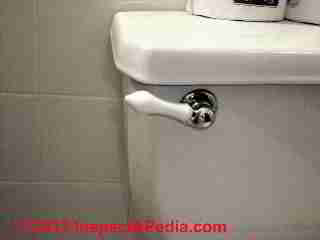
Side-handle flush toilet: the most common toilet flush control uses a lever mounted on the toilet tank side or front near one corner to operate the flush valve. The lever typically lifts an arm that opens the flush valve.
Squat Toilet Designs & Features
Moved to SQUAT TOILETS
Tank Reservoir Toilets - Top Flush Controls Compared with Side Flush & Pedestal Flush
See TOP FLUSH TOILETS.
Toilet Flanges
The toilet flange a brass, plastic, or steel flange forming flat ring around and usually attached to the waste pipe in the floor or wall.
The toilet flange includes openings to permit the flange to be secured to the floor or wall as well as slots to accept the heads of toilet-mounting bolts that secure the toilet to the flange.
A toilet flange is shown in our photo at left (white plastic, below the yellow wax ring) and another toilet flange indicated by the red arrow in this photo.
Toilet Flush Volume Standards & Calculations
This topic has moved to a new article
Toilet Manufacturers & Contact Information
With more than 1000 brands of toilets manufactured and distributed around the world, this list would be endless.
Now at TOILET MANUFACTURERS & SOURCES we list common or popular toilet manufacturers or brands, models, and we give contact information for the various toilet manufacturers.
Toilet mounting bolts
Toilet mounting bolts secure the toilet to the toilet flange and in four-bolt toilets two more lag-bolts may secure the toilet to the floor itself.
Toilet Bolts secure the toilet base to the floor or structure.
Watch out: a poorly-secured toilet not only leaks into the floor, it is dangerous. A disabled person or anyone sitting down onto an insecure toilet can tip the unit over leading to serious injury.
Toilet rough-in dimensions - locating the toilet
Toilet rough-in dimensions locate the toilet waste pipe and flange assembly in the building rough and finished floor so that the toilet will be spaced a proper distance from the wall.
The toilet rough-in dimension illustration (left) shows the standard 12" distance to the waste line center from the finished wall and are illustrated by this adaptation from a Titan toilet package observed in Menards in Duluth MN. Toilets are installed
- 12" from finished wall behind toilet to center of waste line - may vary by toilet model
- 15" from center of toilet to nearest side wall
- 24" clear space in front of the toilet (or more)
- 6" from flushometer to highest fixture part (for flush-o-meter toilets)
Details about how to install a toilet are
at TOILET INSTALLATION PROCEDURE
Toilet Rim Heights for ADA Compliance
Toilet rim heights: the height of the rim of the toilet bowl above the finished floor.
To comply with the Americans with Disabilities Act (ADA) standards (16.5" to 18" above the floor later set to 17-19") or ANSI 117.1a 2003 Safe Harbor standard (17" to 19" above the floor).
"Standard" toilets are a bit shorter, typically 14" to 16" above the floor surface.
Add-on toilet rim height lifters are available that convert a standard toilet to ADA standards height.
Toilet heights or rim heights and ADA requirements are discussed in detail
Also see LOW-HEIGHT TOILETS for non-ADA toilets providing lower toilet seat height from the floor.
ADA also requires grab bars
see details
at GRABRAIL GRAB BAR SPECIFICATIONS
and accessibility space
see BATHROOM DESIGN, ACCESSIBLE for details.
for accessible bathrooms.
Toilet Tank-Reservoir (Cistern) Flush Toilets & How They Work
This topic has moved
Tank reservoir toilets like the toilet in the sketch at left and in our photo just below, have been in wide use in North America since the 1940's.
Top Flush Dual-Flush Control Toilets
Details about water conserving or water saving toilets begin
at TOP FLUSH TOILETS and
Separately at LOW WATER USAGE / POWER FLUSH TOILETS we discuss toilet that use a reduced water quantity, and
at FLUSHMATE TOILETS we discuss power-assisted flush toilets that also conserve water. Excerpts are just below.
Water saving models (typically a pair of buttons giving different flush volumes) illustrated below. Dual-flush water saving toilets typically deliver 1.1 gallons to flush liquid waste or 1.6 gallons to flush solids.
Top Flush Toilet: top-mounted flush controls
Top-flush toilet or top-controls toilet: the flush operating control consists of one or more buttons or rods that project through the top of the toilet tank.
Split top-flush controls permit alternative flush water volumes, typically using a 1.6 gpf flush for solid waste and 1.1 gpf flush for liquid-only waste.
Toilet Water Supply Shutoff Valves or Stop Valves
Toilet supply shut-off valve: (blue arrow in our photo at left) a water shut-off valve installed below or close to water-operated toilets.
Up-flush toilets
An up flush toilet is located below the building's sewer line and uses water pressure to move waste vertically to a drain line that is higher than the toilet itself.
There may be some up-flush toilets with a built in electric pump but we have not found such; instead see Sewage Ejector Pumps above.
See details at BASEMENT & UP-FLUSH TOILETS & EJECTOR PUMPS
Water Level in the Toilet Flush Tank
Water level in the toilet tank: most toilet tanks include a mark on the tank interior indicating the proper fill level for water in the reservoir tank. Adjust your toilet fill valve to fill to this level for proper flushing. Too little water may result in wasting water by having to flush the toilet multiple times.
Filling the toilet above the recommended fill-line wastes water at each flush and risks a "running toilet" if the fill level send water down the overflow tube.
See the water level illustration above next to our definition of Gravity Flush Toilets.
Water Saving Toilets
Water-Saving toilets use a lower total volume of water to flush or clean the toilet bowl, typically between 1.1 gallons per flush (gpf) and 1.6 gallons per flush. Synonyms: low water toilet, low water consumption toilet, low-flush toilet, high-efficiency toilet.
Also see Waterless Toilets listed below.
Water Supply or Fill Valve for Toilets
Water fill or supply valves for toilets toilets: see Ball Cock Valve or toilet fill valve above.
Waterless or No-Water Toilets & Urinals
Waterless toilets are any of a variety of toilet designs that do not rely on water to dispose of waste, including chemical toilets, composting toilets, outhouses, waterless toilets and other alternative toilet designs that are discussed separately
at ALTERNATIVE & WATERLESS TOILETS
and
Also see TOILET DESIGNS, CHOICES where we describe the different toilet flush designs: gravity, power-assisted, and vacuum assisted flushing toilets.
Wax ring for toilets
The to8let wax ring is a large wax seal placed between the bottom of the toilet and the upper surface of the flange or top edge of the waste drain pipe to which the toilet is connected. A wax ring is illustrated above at our discussion of Toilet Flange. Also see the toilet odor or toilet leak troubleshooting tips
Zoeller Quik Jon combines sewage ejector pump & toilet
Moved to BASEMENT TOILET EJECTOR PUMPS-Zoeller QuikJon
Reader Comments, Questions & Answers About The Article Above
Below you will find questions and answers previously posted on this page at its page bottom reader comment box.
Reader Q&A - also see RECOMMENDED ARTICLES & FAQs
On 2022-08-20 by InspectApedia-911 (mod) - advice on finding a replacement lid for a toilet cistern - UK sources
@Dash,
I've seen a similar toilet brand mark - though in blue on the glazed china surface of a toilet base - but haven't yet found exactly where that is in our data (still looking).
The toilet tank lid doesn't need to match exactly; it can be a bit larger, as long as its depth doesn't so intrude towards the front of the toilet as to block keeping the lid or seat raised.
At
TOILET CISTERN / TANK LID REPLACEMENTS we list sources of toilet cistern lids in the UK - we'll repeat your question there and reply in more-detail.
For older toilets, brands, manufacturers, sources, see also
ANTIQUE FLUSH TOILETS
On 2022-08-20 by Dash - replacement cistern cover for Toilet Brand Mark "S 650" in a 1980s home
@InspectApedia-911,
Sure, sorry I realise now it was lacking basic info.
Location: UK, North London.
The item in question is a toilet, the image in inside the tank lid. It has that "S" shape then the number "650".
I moved into my home in November 2020. its a 1980's build house. I do not believe the toilet in from that era as the rest of the bathroom is modern and it is an enclosed toilet.
the lid in question has a crack in it and i would like to replace it.
On 2022-08-19 by InspectApedia-911 (mod) - Identify "S" like toilet logo or brand
@Dash,
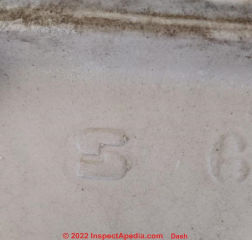 Thank you for the question and photo. We could be more helpful and research more thoroughly and more quickly to give a more useful answer if you would help us out first with a bit of very basic information.
Thank you for the question and photo. We could be more helpful and research more thoroughly and more quickly to give a more useful answer if you would help us out first with a bit of very basic information.
Basic information includes things such as
Location:
Country and city of location, where are the object of your question was found. Our readers are in 52 countries around the world.
Surrounding context:
By contact I mean I formation such as history of a site or building or name and (if known) age of site or building where an object that is the subject of a question has been found.
That might help narrow down toilet age and manufacturer.
On 2022-08-19 by Dash
Could I get some help with this toilet brand please.
[Photo above]
On 2022-08-20 by InspectApedia-911 (mod) -
@Andrewsjs09,
Take a look at the brand on the toilet base - you'll find that at
TOILET MANUFACTURERS & SOURCES
inspectapedia.com/plumbing/Toilet_Manufacturers_Sources.php
Look under "F" for Ferguson Toilets

On 2022-06-14 by Andrewsjs09
Need to know what kinds toilet this is so i can order a replacement tank cover
On 2022-03-31 by Mak Church (mod)
@Fred Anderson,
Continuing -
If you can post a photo of the toilet, we're curious to see the color.
On 2022-03-30 by Inspectapedia Com Moderator (mod)
@Fred Anderson,
OK so that's a back-flush toilet; perfectly usable if the bowl and tank aren't damaged.
See BACK FLUSH & WALL MOUNT TOILETS
https://inspectapedia.com/plumbing/Back-Flush-Toilet-Guide.php
On 2022-03-30 by Fred Anderson
we have a one piece toilet from the 80's. no numbers or name. they want to keep it because of the color. It has only 2 bolts attached to the wall
On 2022-01-21 by Inspectapedia Com Moderator (mod)
@Amber Hodge,
That looks like a manufacturing date code and possibly, above it, a part or model number; Regrettably from that alone we don't have a reliable guess at the toilet brand. See if you can find any other markings on the bowl or tank.
On 2022-01-21 by Amber Hodge
I need help identifying this toilet manufacturer
On 2021-03-09 by (mod) - triangular cistern for 1963 corner toilet
@Timothy DeWein,
Corner Toilets: an old design, still available, to fit a toilet into a corner
Yes, Timothy, corner toilets are uncommon but certainly have been made for a very long time, also corner lavs or sinks, typically where it's otherwise difficult to squeeze in the toilet or sink into a small space.
Incidentally standard toilet repair kit parts will probably fit and work in that corner toilet; if not check the parts provided by current corner-toilet manufacturers.
Currently many of the larger toilet manufacturers such as American Standard (shown below), Toto, Sheffield, Signature Hardware (Regent toilet) all make toilets with a reservoir tank or cistern shaped to fit into a corner; some of these toilets also back-flush into a corner.
On 2021-03-09 by Timothy DeWein
My daughter planned to replace the tank guts of her 1963 corner toilet and didn't save the old parts. I've never seen a tank like this. Have you?
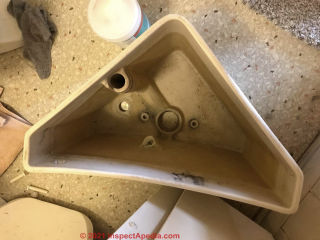
On 2020-11-22 - by (mod) -
Sorry Paula but without a shred of identification we're spinning our proverbial wheels making up an answer.
There are still toilets that vent and remove odors including some power-flush toilets and of course special toilets like some incinerating toilet models.
On 2020-11-22 y Paula Rice
When my parents renovated an old house in the late 60’s they bought a toilet that had an anti stink feature where you would lift the handle up and it would bubble and suck any odor away. We don’t live there anymore so I can’t tell you the model, but we got it in 1968.
Any idea if that feature is used today, and how it worked? All 3 of us kids remember this feature because in a 1 bath house we were reminded “to turn on the sucker”if we were going to be stinking up the bathroom.
On 2020-09-14 by (mod)
Aruna
Luckily there are generic toilet repair parts for flush mechanisms that will work in just about every toilet on the market. Take the old parts to your local building supplier and look through the repair kits.
The Fluidmaster universal toilet repair kit shown below is sold at plumbing and building suppliers and may work for you.
On 2020-09-14 by Aruna
I have two old toilets and would like to replace the parts in the tanks (they are still in working condition but before they break I better replace the mechanism)
1- Blue Toilet Tank- Crane Canada 275 30465 this is the # in the tank. 17 5 65 # on the lid of the Toilet
2- Yellow Toilet Tank- Crane Canada 229. 15 6 64 # on the lid of the toilet.
My house is built in the 1960's. Your response will be greatly appreciated. My email address is aruna.ghatalia@gmail.com
On 2020-03-24 - by (mod) - Briggs Insulated Toilet tank replacement
Yes and yes
On 2020-03-24 by Diane
I have a Briggs insulated toilet tank with 1.6 gpf. The base has the s curve going to the drain pipe.
Can I replace that tank with a non insulated tank?
And does it have to be the same water flow at 1.6 gpf?
On 2020-01-06 - by (mod) - Briggs Toilet with no rim jets
Chris I can't see enough from your note to know what's wrong but I'd start by looking into the cistern or water tank for the toilet; you may simply need to replace the fill valve or the flush valve assembly.
If the toilet cistern fills and the flush valve works and flushes the bowl and the only complaint is that the rim jets are clogged, you may be able to unclog them by cleaning and use of vinegar.
On 2020-01-06 by Chris
I have a Briggs toilet with no rim jets no visible jets in the bowl.
It only flushes with a bucket of water. What can I do?
On 2018-07-06 by (mod) - Briggs Plumbing contact information
Ronnie
The only Briggs company we find current is
Briggs Toilets, Briggs Plumbing 597 Old Mt Holly Rd Goose Creek, SC 29445 Customer Service department at 1-800-888-4458
Watch out: as per our last access in July 2018. the Briggs Plumbing website https://briggsplumbing.com/ may have malware and viruses that can infect your computer
On 2018-07-06 by Ronnie
Are Briggs toilets still manufactured ? If so, where can I find a dealer?
On 2020-02-19 - by (mod) - Olsonite 258 1 54 toilet parts
Dave: try attaching a photo - use the Add Image button- one per comment - of the toilet and of the Olsonite brand you found and of the parts you need
On 2020-02-19 by Dave
Have two about 1954 toilets the same. No brand names on toilets except one has Olsonite 258 1 54 on bottom of tank lid.. need parts .
On 2014-12-17 - by (mod) - calculating toilet flush volume at
Anon,
I have posted a detailed answer to calculating toilet flush volume at
https://inspectapedia.com/plumbing/Toilet_Types.htm#TVolume
On 2014-12-16 by Anonymous
Is there a way to quickly identify the gallons per flush of commercial toilets (flushometer style) without taking them apart or metering flow? I know most newer toilets list the rate on the back of the bowl, but I’m not sure all do and older models do not. So, how do you know if you have an older 3.5 gpf (or more) unit or a newer 1.6 that just isn’t marked?
On 2014-11-19 - by (mod) -
Anon:
Simplest approach is to turn off water supply to the toilet, drain and dry the tank or cistern, then remove the whole assembly and take it to your local plumbing supplier. Low profile toilets are more likely to require an OEM flush control assembly.
On 2014-11-19 by Anonymous
my flusher came apart from bottom of water release valve inside tank but I don't know what type of tank I have.Its low sitting bowl big at bottom need whole new handle
On 2014-11-04 - by (mod) -
Mike you can call Kohler parts at
1-800-456-4537
On 2014-11-04 - by (mod) -
Hi Michael. The part you describe is a Kohler valve. Have you tried contacting the company?
On 2014-11-04 by michael
BALL COCK FILL VALVE FOR A VINTAGE KOHLER TOILET K 6946 8. The water suppy enters the top left back wall corner of the tank and supplies the ball cock fill valve . I am looking to repair or replace this valve . I do not know what make or type of valve this is . Does anyone know the answer to this question thanks . .
On 2014-09-17 - by (mod) -
Jennifer
Unless you are required to preserve antiquated plumbing fixtures, say for historical reasons, it will be faster and less costly to simply install a complete new toilet. But first check to see exactly what's leaking as you might face a simple repair of a gasket or seal.
On 2014-09-17 by Jennifer
We have an old American Standard, wall mounted tank. Rough measure from back wall to bolts is 15 1/4". There is a 45 angle pipe connecting tank and bowl. It's leaking and needs to be replaced, but with what?
...
Continue reading at TOILET REPAIR GUIDE or select a topic from the closely-related articles below, or see the complete ARTICLE INDEX.
Or see TOILET TYPES, CONTROLS, PARTS FAQs - questions & answers posted originally at this page
Or see these
Recommended Articles
- BATHROOM DESIGN, ACCESSIBLE - ADA requirements for accessible toilets
- COMPOSTING TOILETS
- CONTEMPORARY TOILET DESIGNS
- DESIGN SPECS HOLDING TANKS, WATERLESS TOILETS
- TOILETS, INSPECT, INSTALL, REPAIR - home
- TOILET CLOG REPAIR, UN-BLOCK
- TOILET DESIGN CHOICES
- TOILETS, DON'T FLUSH LIST - home
- TOILET DRAIN CLOGGED
- TOILET FLUSH OPERATION
- TOILET FLUSH HANDLE LEVER REPLACEMENT
- TOILET INSTALLATION PROCEDURE
- TOILET, LOW-HEIGHT
- TOILET MANUFACTURERS & SOURCES - identify toilet brands, find toilet parts
- TOILET REPAIR GUIDE - home
- TOILET RIM HEIGHT & ADA
- TOILET TYPES, CONTROLS, PARTS
- ALTERNATIVE & WATERLESS TOILETS
- ANTIQUE FLUSH TOILETS
- BACK FLUSH & WALL MOUNT TOILETS
- BASEMENT & UP-FLUSH TOILETS & EJECTOR PUMPS
- BIDETS
- CAMPING & EMERGENCY USE TOILETS
- CHEMICAL TOILETS
- COMPOSTING TOILETS
- COMPOSTING TOILET SUPPLIES
- CONTEMPORARY TOILET DESIGNS
- CUSTOM TOILETS
- DEFINITIONS of TOILET PARTS & TERMS
- DISABLED or ELDERLY-USE TOILETS
- DISASTER ZONE TOILET GUIDE
- DUAL FLUSH TOILETS
- ELECTRIC FLUSH TOILETS
- EMERGENCY TOILETS
- FLUSHMATE TOILETS
- FLUSHOMETER TOILETS & URINALS
- FLUSHOMETER VALVES for TOILETS URINALS
- GREYWATER TOILETS & SEPTICS
- INCINERATOR TOILET SYSTEMS
- IN-WALL FLUSH TANK TOILETS
- LATRINE TYPES & CONSTRUCTION
- LOW COST TOILETS
- LOW-HEIGHT TOILETS
- LOW PROFILE TOILETS
- LOW WATER USAGE / POWER FLUSH TOILETS
- MARINE TOILETS
- OUTHOUSES & LATRINES
- RV HOLDING TANK DUMP INTO SEPTIC TANK?
- SEWAGE HOLDING TANKS
- SQUAT TOILETS
- TOILET RIM HEIGHT & ADA
- TOILET SEAT / SEAT-LID REPLACEMENT & BOLT SPREADS
- TOILET TANK / CISTERN LID REPLACEMENTS
- TOP FLUSH TOILETS
- WATERLESS TOILETS
- WATERLESS URINALS
Suggested citation for this web page
TOILET TYPES, CONTROLS, PARTS at InspectApedia.com - online encyclopedia of building & environmental inspection, testing, diagnosis, repair, & problem prevention advice.
Or see this
INDEX to RELATED ARTICLES: ARTICLE INDEX to TOILET INFORMATION
Or use the SEARCH BOX found below to Ask a Question or Search InspectApedia
Ask a Question or Search InspectApedia
Try the search box just below, or if you prefer, post a question or comment in the Comments box below and we will respond promptly.
Search the InspectApedia website
Note: appearance of your Comment below may be delayed: if your comment contains an image, photograph, web link, or text that looks to the software as if it might be a web link, your posting will appear after it has been approved by a moderator. Apologies for the delay.
Only one image can be added per comment but you can post as many comments, and therefore images, as you like.
You will not receive a notification when a response to your question has been posted.
Please bookmark this page to make it easy for you to check back for our response.
Our Comment Box is provided by Countable Web Productions countable.ca
Citations & References
In addition to any citations in the article above, a full list is available on request.
- "Story: Rock, limestone and clay Part of page 8 – Ceramics and pottery ", TEARA, The Enyclopedia of New Zealand, Video retrieved 9/18/14, original source: http://www.teara.govt.nz/en/video/5254/clay-toilets, Te Ara, Manatū Taonga Ministry for Culture and Heritage, PO Box 5364, Wellington, New Zealand, Tel: +64 4 499 4229, Email: TeAra@mch.govt.nz
- [1] Carson Dunlop provides home inspection education including the ASHI-adopted a Home Inspection Home Study Course, and publications such as the Home Reference Book, the Home Reference eBook, and report writing materials including the Horizon report writer, and home inspect ion services. Alan Carson is a past president of ASHI, the American Society of Home Inspectors.
- [2] 1991 ADA Standards for Accessible Design, U.S. Department of Justice, 28 CFR Part 36, Revised as of July 1, 1994, excerpts; web search 5/10/12, original source: http://www.ada.gov/stdspdf.htm [copy on file as ADA_Standards_1994.pdf]
- [3] Alliance for Water Efficiency, 300 W Adams Street, Suite 601
Chicago, Illinois 60606, Tel: 866-730-A4WE, Website: http://www.allianceforwaterefficiency.org/ Quoting:
The Alliance for Water Efficiency is a stakeholder-based 501(c)(3) non-profit organization dedicated to the efficient and sustainable use of water. Located in Chicago, the Alliance serves as a North American advocate for water efficient products and programs, and provides information and assistance on water conservation efforts. - OSHA toilet standards: OSHA's sanitation standard for general industry, 29 CFR 1910.141(c)(l)(i), specifies that employers shall provide toilet facilities for their employees. Web-search 5/10/12, original source:
http://www.osha.gov/pls/oshaweb/owadisp.show_document?p_id
=22932&p_table=INTERPRETATIONS - [4] Toilet Manufacturers' Product literature or websites were consulted for the following:
- American Standard brand toilets (illustrated in this article), includes these additional plumbing fixture & component brands: Jade, Porcher (see below), Crane Plumbing, Eljer, Fiat, American StandardsProSite, Safety Tubs, http://www.americanstandard-us.com/
- Atlas International brand toilets, Atlas USA, http://atlasusa.net/
- Barclay brand toilets, Barclay Products Limited, 4000 Porett Dr., Gurnee, IL 60031, 847-244-1234, website: http://www.barclayproducts.com/
- Caroma brand toilets, Caroma is Australian company; in Canada & the USA Tel: 800-605-4218, website: http://www.caromausa.com/
- Church Seats, [toilet seats only], http://www.churchseats.com/ - our photo (left) shows a church toilet seat installed.
- Circle City Copperworks 9325 Uptown Dr., Suite 500 Indianapolis, IN 46256-1079, sinks, other copper products, not toilets, website: http://www.circlecitycopperworks.com/
- Crane Plumbing - see American Standard Products, above
- Danze brand toilets, Tel: USA: 1-877-530-3344, Canada: 1-866-884-8841 http://www.danze.com/room_solutions.asp
- Eljer brand toilets, (e.g. Titan one-piece elongated bowl 16 1/8" ADA-compliant)
- Gerber brand toilets (e.g. Gerber Ultra Dual Flush elongated ErgoHeight DF-21-318 pressure-assisted 1.6 gallon flush unit.), USA: 1-866-538-5536 (9AM-6PM) Mon-Fri Canada: 1-866-884-8841 (8:30AM-5PM) Mon-Fri, http://www.gerberonline.com/default.aspx
- Glacier Bay brand toilets, [Home Depot brand] porcelain, made in china, top flush control low-water ADA-height unit shown in this article. Cf. Globe Union Industrial Company of Canada, China, elsewhere. Also see Pegasus, Danze, Gerber. Glacier Bay Faucets and sanitaryware, 2455 Paces Ferry Road NW, .Atlanta, Ga. 30339-4024, 800-220-3036. http://www.glacierbayfaucetsreview.com/
- Hastings Tile & Bath toilets, includes "hatbox" and wall mount sinks, bidets, & toilets, 30 Commercial Street Freeport, N. Y. 11520, Tel: (516) 379-3500. http://www.hastingstilebath.com,
- Herbeau Creations brand toilets, Herbeau Creations of America 3600 Westview Drive Naples, FL 34104, Tel: (800) 547-1608, (since 1857), http://www.herbeau.com/Products.aspx?Item=5501
- Inax brand toilets, 15 West 20th Street, New York, NY 10011, Tel: 855-823-4434, http://www.inax-usa.com/gallery-ny/
- Jacuzzi brand toilets, Tel: 800-288-4002., website: http://www.jacuzzi.com/
- Jade, see American Standard Products, above
- Jemal Wright Bath Designs toilets, Brazil & USA, 3140 SW 19th St. #572, Hallandale FL 33009 USA, Tel: 305-915-0960, email: info@jemalwright.com, website: http://www.jemalwright.com/
- Kohler® brand toilets, Kohler Co. 444 Highland Drive Kohler, WI 53044, Tel 800-456-4537, Website http://www.kohler.com/corporate/index.html
- Laufen Ceramicware brand toilets, world wide, LAUFEN Bathrooms AG Wahlenstrasse 46 CH-4242 Laufen, USA: Laufen Bathrooms North America 11190 NW 25th Street Miami, FL 33172, Tel: Tel: +1 866.696.2493 / +1 305.357.6130, Website: http://www.laufen.com
- LeBijou brand toilets, - good luck finding this company or a home page for them - Ed.
- Mirabelle brand toilets (e.g. Key West MIRKW241ABS), showrooms in the U.S. & Canada, Email: info@mirabelleproducts.com, Website: http://www.mirabelleproducts.com/
- Nameek's brand toilets, 1561 Gehman Rd., Harleysville, PA 19438, Tel: (215) 256-4197, Website: http://www.nameeks.com/Bathroom/
- Neo-Metro Collection brand toilets, Neo-Metro 15125 Proctor Ave City of Industry CA 91746 U.S.A, Tel: 800.591.9050, Website: http://www.neo-metro.com
- Panasonic brand toilets, (e.g. Panasonic toilet bowl with warm water flush system for washing user beauty cabinet de toilette W moment-type pearl ivory DL-WD60-CP; also the Zaraku portable toilet - http://ex-blog.panasonic.co.jp/exhibition/en/2008/09/hcr08_400.html)
- Porcher brand toilets, originally a French brand, acquired by American Standard Companies in 1992, Website: http://www.porcher-us.com/
- ProFlo brand toilets (e.g. Proflo PFCT 103WH)
- Rapsel brand toilets,RAPSEL Spa Via Volta 13 - 20019 Settimo Milanese (MI), Italy Tel. 0039 02 3355981 Fax. 0039 02 33501306, Email: rapsel@rapsel.it Italian company, offices in Milan & New York, Website: http://www.rapsel.it/ or in the U.S. http://rapsel.wordpress.com/
- Samuel Heath brand toilets, US & UK, USA Customer Service 111 E. 39th St. 2R New York NY 10016, Tel: 212 599 5177, Email: usa@samuel-heath.com, or UK Head Office Samuel Heath & Sons plc Leopold Street Birmingham B12 0UJ, Tel: +44 121 766 4200, Email: info@samuel-heath.comWebsite: http://www.samuel-heath.com/
- Sterling brand toilets (e.g. Rockton S4020880), Sterling Plumbing 444 Highland Drive Kohler, WI 53044, Tel: 800-783-7546, Website: http://www.sterlingplumbing.com/
- St. Thomas Creations brand toilets, St. Thomas Creations 3A South Middlesex Avenue Monroe Township, New Jersey 08831 USA, Tel. (800) 536-BATH (800-536-2284) Fax (609) 655- 2421, Email: E-Mail: info@stthomascreations.com, Website: http://www.stthomascreations.com/
- Toto brand toilets (e.g. Toto Drake CST744S, Neorest Hybrid, ) Brazil & USA, TOTO USA, INC. 1155 Southern Road Morrow, Georgia 30260, Tel: 888-295-8134, Tel: 1-888-295-8134, Email: custservice@totousa.com techsupport@totousa.com, Website: http://www.totousa.com
- Villeroy & Boch Bath & Kitchen brand toilets, International, offices in Canada, Mexico, United States, Villeroy & Boch AG Corporate Headquarters P.O. Box 1120 D 66688 Mettlach, Phone +49 (0) 68 64 - 81 - 0, Website: http://www.villeroy-boch.com/, Company founded 1748.
- VitrA USA brand toilets, International, Brazil?, USA contact: Shawnee North Business Center 305 Shawnee North Drive Suite 600 Shawnee USA, Phone : +1 770 904 68 30 Fax : +1 770 904 68 91 www.vitra-usa.com, Website: http://usa.vitra.com.tr/
- Whitehaus Collection brand toilets, Whitehaus Collection - 589 Boston Post Rd. West Haven, CT 06516 USA, Tel: 800.527.6690, Email: info@whitehauscollection.com, Website: http://whitehauscollection.com
- [5] Wikipedia Web: https://www.wikipedia.org/ provided background information about some topics discussed at this website provided this citation is also found in the same article along with a " retrieved on" date. NOTE: because Wikipedia entries are fluid and can be amended in real time, we cite the retrieval date of Wikipedia citations and we do not assert that the information found there is necessarily authoritative.
- "Flush Toilet", web search 5/10/12, original source: http://en.wikipedia.org/wiki/Flush_toilet#Tank_style_with_flapper-flush-valve
- "Japanese bidet toilet", web search 5/13/12, original source: http://en.wikipedia.org/wiki/Japanese_toilets
McMahon, M.A.S., & Wilson, I.G. (2001). The occurrence of enteric pathogens and Aeromonas species in organic vegetables. International Journal of Food Microbiology, 70(1-2),155-162.
- US EPA ONSITE WASTEWATER TREATMENT SYSTEMS MANUAL [online copy, free] Top Reference: US EPA's Design Manual for Onsite Wastewater Treatment and Disposal, 1980, available from the US EPA, the US GPO Superintendent of Documents (Pueblo CO), and from the National Small Flows Clearinghouse. Original source http://www.epa.gov/ORD/NRMRL/Pubs/625R00008/625R00008.htm Onsite wastewater treatment and disposal systems, Richard J Otis, published by the US EPA. Although it's more than 20 years old, this book remains a useful reference for septic system designers. U.S. Environmental Protection Agency, Office of Water Program Operations; Office of Research and Development, Municipal Environmental Research Laboratory; (1980)
- Eco John® Innovative Toilet Solutions, Global Inventive Industries, Fountain Valley CA, PDF, product brochure
- "International Private Sewage Disposal Code," 1995, BOCA-708-799-2300, ICBO-310-699-0541, SBCCI 205-591-1853, available from those code associations.
- "Manual of Policy, Procedures, and Guidelines for Onsite Sewage Systems," Ontario Reg. 374/81, Part VII of the Environmental Protection Act (Canada), ISBN 0-7743-7303-2, Ministry of the Environment,135 St. Clair Ave. West, Toronto Ontario M4V 1P5 Canada $24. CDN.
- Manual of Septic Tank Practice, US Public Health Service's 1959.
- Onsite Wastewater Disposal, R. J. Perkins; Quoting from Amazon: This practical book, co-published with the National Environmental Health Association, describes the step-by-step procedures needed to avoid common pitfalls in septic system technology. Valuable in matching the septic system to the site-specific conditions, this useful book will help you install a reliable system in both suitable and difficult environments. Septic tank installers, planners, state and local regulators, civil and sanitary engineers, consulting engineers, architects, homeowners, academics, and land developers will find this publication valuable.
- Onsite Wastewater Treatment Systems, Bennette D. Burks, Mary Margaret Minnis, Hogarth House 1994 - one of the best septic system books around, suffering a bit from small fonts and a weak index. While it contains some material more technical than needed by homeowners, Burks/Minnis book on onsite wastewater treatment systems a very useful reference for both property owners and septic system designers.
- Septic System Owner's Manual, Lloyd Kahn, Blair Allen, Julie Jones, Shelter Publications, 2000 $14.95 U.S. - easy to understand, well illustrated, one of the best practical references around on septic design basics including some advanced systems; a little short on safety and maintenance. Both new and used (low priced copies are available, and we think the authors are working on an updated edition--DF. Quoting from one of several Amazon reviews: The basics of septic systems, from underground systems and failures to what the owner can do to promote and maintain a healthy system, is revealed in an excellent guide essential for any who reside on a septic system. Rural residents receive a primer on not only the basics; but how to conduct period inspections and what to do when things go wrong. History also figures into the fine coverage.
- US EPA ONSITE WASTEWATER TREATMENT SYSTEMS MANUAL Top Reference: US EPA's Design Manual for Onsite Wastewater Treatment and Disposal, 1980, available from the US EPA, the US GPO Superintendent of Documents (Pueblo CO), and from the National Small Flows Clearinghouse. Original source http://www.epa.gov/ORD/NRMRL/Pubs/625R00008/625R00008.htm
- Water Wells and Septic Systems Handbook, R. Dodge Woodson. This book is in the upper price range, but is worth the cost for serious septic installers and designers.
Quoting Amazon: Each year, thousands upon thousands of Americans install water wells and septic systems on their properties. But with a maze of codes governing their use along with a host of design requirements that ensure their functionality where can someone turn for comprehensive, one-stop guidance? Enter the Water Wells and Septic Systems Handbook from McGraw-Hill.
Written in language any property owner can understand yet detailed enough for professionals and technical students this easy-to-use volume delivers the latest techniques and code requirements for designing, building, rehabilitating, and maintaining private water wells and septic systems. Bolstered by a wealth of informative charts, tables, and illustrations, this book delivers:
* Current construction, maintenance, and repair methods
* New International Private Sewage Disposal Code
* Up-to-date standards from the American Water Works Association
- Wells and Septic System, Alth, Max and Charlet, Rev. by S. Blackwell Duncan, $ 18.95; Tab Books 1992. We have found this text very useful for conventional well and septic systems design and maintenance --DF. Quoting an Amazon description:Here's all the information you need to build a well or septic system yourself - and save a lot of time, money, and frustration. S. Blackwell Duncan has thoroughly revised and updated this second edition of Wells and Septic Systems to conform to current codes and requirements. He also has expanded this national bestseller to include new material on well and septic installation, water storage and distribution, water treatment, ecological considerations, and septic systems for problem building sites.
- The NSFC Products List has an excellent list of design manuals/modules National Small Flows Clearinghouse (NSFC) now (2019/12/13) hosted at http://www.nesc.wvu.edu/ Tel: 304-293-4191 e-mail info@mail.nesc.wvu.edu.
The National Small Flows Clearinghouse (NSFC) was funded by the U.S. Environmental Protection Agency (EPA) to help America's small communities and individuals solve their wastewater problems through objective information about onsite wastewater collection and treatment systems. NSFC products and information are the only national resource of its type, dealing with small community wastewater infrastructure. or by telephone 800-624-8301 - In addition to citations & references found in this article, see the research citations given at the end of the related articles found at our suggested
CONTINUE READING or RECOMMENDED ARTICLES.
- Carson, Dunlop & Associates Ltd., 120 Carlton Street Suite 407, Toronto ON M5A 4K2. Tel: (416) 964-9415 1-800-268-7070 Email: info@carsondunlop.com. Alan Carson is a past president of ASHI, the American Society of Home Inspectors.
Thanks to Alan Carson and Bob Dunlop, for permission for InspectAPedia to use text excerpts from The HOME REFERENCE BOOK - the Encyclopedia of Homes and to use illustrations from The ILLUSTRATED HOME .
Carson Dunlop Associates provides extensive home inspection education and report writing material. In gratitude we provide links to tsome Carson Dunlop Associates products and services.


